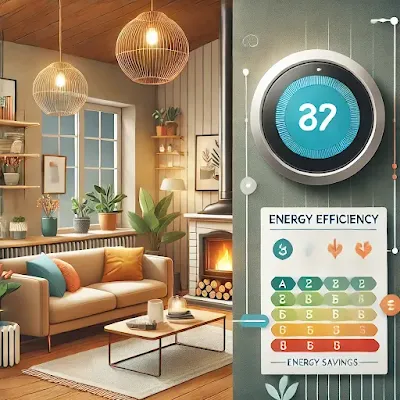How Thermostat Settings Can Reduce Energy Bills
Energy bills are a major concern for households, especially during colder months when heating usage spikes. With simple adjustments to your thermostat and better management of your heating system, you can significantly lower costs while maintaining comfort. Here’s how to optimize your energy usage.
1. Lower Boiler Flow Temperature for Savings
Adjusting your boiler flow temperature is an effective way to save energy and reduce costs.
- What Is Boiler Flow Temperature? The temperature at which water is sent from your boiler to your radiators.
- Recommended Setting: Lowering it to around 60°C reduces energy usage while still providing adequate warmth.
- Potential Savings: Households can save a significant amount annually by simply adjusting this setting.
2. Set Your Thermostat for Maximum Efficiency
Choosing the right thermostat setting is crucial for balancing comfort and cost.
- Optimal Temperature: Keep your thermostat at 18-20°C when at home and awake. Lower it to 15-16°C when sleeping or away.
- Impact: Consistently following these settings can cut heating bills by a substantial percentage.
3. Improve Radiator Efficiency
Making your radiators more efficient ensures your heating system works effectively without increasing energy costs.
- Bleed Your Radiators: Removing trapped air improves heat distribution.
- Use Reflective Foil: Placing foil behind radiators directs heat into the room instead of being absorbed by walls.
- Targeted Heating: Turn off radiators in unused rooms to focus heat where it’s needed most.
4. Consider a Smart Thermostat
Smart thermostats provide precise control over your heating system, optimizing energy usage automatically.
- Benefits:
- Adjust settings based on your daily habits.
- Remote control via smartphone for on-the-go changes.
- Savings: These devices can reduce heating costs by up to 15% annually.
5. Maintain Your Heating System
Regular maintenance ensures your heating system operates efficiently.
- Annual Boiler Servicing: Prevents breakdowns and ensures optimal performance.
- Check Insulation: Properly insulated homes retain heat better, reducing the need to increase thermostat settings.
Frequently Asked Questions (FAQs)
1. What is the best thermostat setting to save energy?
The ideal range is 18-20°C when you’re home and 15-16°C when you’re asleep or away.
2. Can lowering boiler flow temperature reduce costs?
Yes, setting the boiler flow temperature to around 60°C can lower energy bills significantly without sacrificing comfort.
3. How do smart thermostats help save money?
Smart thermostats learn your heating preferences and adjust settings automatically, ensuring energy is used efficiently.
4. Should I turn off radiators in unused rooms?
Yes, turning off radiators in rooms you don’t use helps focus heating on active spaces, lowering overall energy usage.
5. Does bleeding radiators really save energy?
Yes, it improves the efficiency of your heating system by ensuring even heat distribution and reducing boiler strain.
Conclusion
Reducing energy bills doesn’t require drastic changes—small adjustments like lowering your boiler flow temperature, setting your thermostat to optimal levels, and maintaining your heating system can lead to substantial savings. By incorporating these tips into your daily routine, you can enjoy a warm and energy-efficient home all year round.



Community Rules & Guidelines
1: Do not post email-id or any kind of personal information.
2: Do not post your own blog/website links.
3: For Help & Support use the Contact Us form.